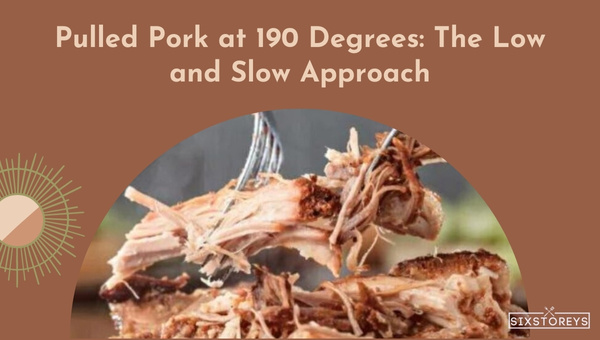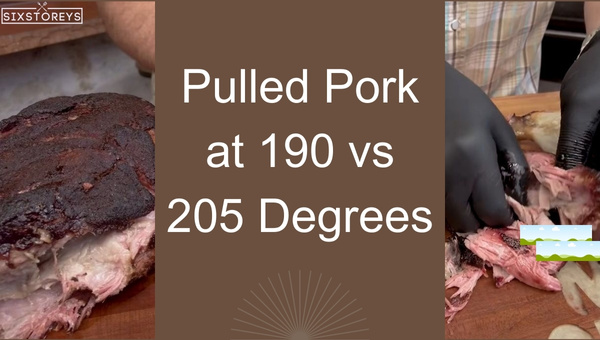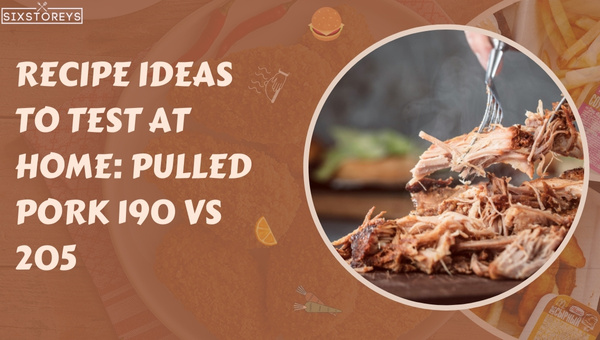Introduction

Finding the ideal temperature for cooking pulled pork is a never-ending debate among barbecue enthusiasts and pitmasters. The battle between pulling the pork at 190°F or 205°F has divided backyard grillers and professional smokers for years. The internal temperature plays a crucial role in determining the tenderness, juiciness, and overall flavor of the pulled pork. In this article, we will explore the basics of cooking pulled pork, the significance of internal temperature, and compare the effects of pulling the pork at 190°F versus 205°F. By understanding these factors, you can determine the ideal internal temperature for achieving pulled pork perfection.
Background On Cooking Pulled Pork
Pulled pork has a long-standing history in American barbecue culture. It originated in the Southern United States, where slow-cooked meats were a staple of traditional outdoor pit cooking. The process involves slow-smoking a pork shoulder or Boston butt, allowing the collagen in the meat to break down and create a tender and flavorful result. Traditionally, the pork is cooked low and slow over charcoal or wood for several hours until it reaches the desired internal temperature. This slow cooking method imparts a smoky flavor and tenderizes the meat, making it perfect for pulling apart into succulent strands.
Importance Of Internal Temperature In Pulled Pork
The internal temperature of pulled pork is of utmost importance for achieving the desired texture, flavor, and safety of the meat. Cooking pork to the correct internal temperature ensures that it is fully cooked and safe to consume, eliminating any risk of foodborne illnesses. Additionally, reaching the optimal internal temperature helps break down the collagen in the meat, resulting in tender, juicy, and flavorful pulled pork. It also allows the connective tissues to melt, making the meat easier to shred. Therefore, monitoring and achieving the right internal temperature is crucial for a successful pulled pork dish.
Pulled Pork Cooking Basics

When it comes to cooking pulled pork, there are a few basic factors to consider. First, choosing the right cut of meat is essential for achieving the desired tenderness and flavor. Pork shoulder or Boston butt are popular choices due to their marbling and connective tissues. Next, preparing the meat by seasoning it with a dry rub or marinade helps enhance the flavor. Cooking methods can include smoking, slow roasting, or using a crockpot. The cooking time and temperature vary depending on the method chosen, but low and slow cooking is generally recommended for tender, juicy pulled pork.
Best Cuts Of Meat For Pulled Pork
When it comes to achieving tender and flavorful pulled pork, the choice of meat is crucial. The best cuts for this dish are pork shoulder or Boston butt. These cuts are known for their marbling and connective tissues, which break down during the slow cooking process, resulting in juicy and tender meat. The marbling adds richness and flavor to the final product. Both pork shoulder and Boston butt provide the ideal balance of fat and meat, making them perfect for creating succulent pulled pork.
Preparation Methods For Optimal Results
To achieve optimal results when cooking pulled pork, it is important to follow proper preparation methods. Start by trimming any excess fat from the meat to ensure even cooking. Next, generously season the pork with a dry rub or marinade of your choice, allowing it to sit for at least a few hours or overnight to enhance the flavor. When it comes to cooking, slow and low is the key. Whether you choose to smoke, roast, or use a slow cooker, cooking the pork at a low temperature for an extended period allows the meat to become tender and juicy. Lastly, after cooking, let the pork rest for a few minutes before pulling it apart to lock in the juices. These preparation methods will help you achieve the best-tasting pulled pork.
Internal Temperature Of Pulled Pork

The internal temperature of pulled pork is a crucial factor in determining its doneness and overall quality. To ensure safe consumption, the USDA recommends that pork should be cooked to an internal temperature of at least 145°F (63°C). However, when it comes to pulled pork, achieving a higher internal temperature is necessary for the meat to become tender and easily pulled apart. Most experts suggest cooking pulled pork to an internal temperature between 190°F (88°C) and 205°F (96°C) for optimal texture and flavor. This temperature range allows the meat to reach a perfect balance of tenderness while still retaining moisture and juiciness. It is important to use a reliable meat thermometer to accurately measure the internal temperature and ensure safe consumption.
Significance Of Internal Temperature In Determining Doneness
The internal temperature of pulled pork plays a crucial role in determining its doneness. The internal temperature is an accurate indicator of how thoroughly the meat has been cooked. A safe internal temperature of 145°F (63°C) is necessary to ensure that the pork is fully cooked and safe to eat. However, when it comes to pulled pork, achieving a higher internal temperature is essential for the meat to become tender and easily pulled apart. This higher temperature allows the collagen in the meat to break down, resulting in a more desirable texture and mouthfeel. By monitoring the internal temperature, you can ensure that your pulled pork is cooked to perfection.
Standard Temperature Guidelines For Safe Consumption
The standard temperature guidelines for safe consumption of pulled pork recommend an internal temperature of 145°F (63°C). This ensures that the pork is fully cooked and safe to eat. However, for pulled pork to reach its desired texture and tenderness, a higher internal temperature is necessary. Experts recommend cooking pulled pork to an internal temperature between 190°F and 205°F (88°C to 96°C) for optimal results. This higher temperature allows the collagen in the meat to break down, resulting in a tender and flavorful pulled pork that is safe and enjoyable to consume.
Pull Pork 190°F Vs. 205°F

The debate between cooking pulled pork at 190°F and 205°F lies in the texture and tenderness of the meat. At 190°F, the pork will have a firmer and sliceable texture, which can be ideal for certain dishes. On the other hand, cooking at 205°F will result in a more tender and shreddable consistency, perfect for classic pulled pork sandwiches. Ultimately, the desired texture and tenderness will depend on personal preference and the specific dish being prepared. It is important to note that both temperatures are safe for consumption, ensuring fully cooked pork.
Effects Of Pulling Pork At 190°F
Pulling pork at 190°F results in a firmer and sliceable texture. This temperature allows the meat to cook slowly, breaking down the connective tissues and rendering the fat, resulting in a tender and flavorful pork. The lower temperature ensures that the pork retains its moisture and prevents it from becoming dry. The firm texture of the meat makes it ideal for dishes where sliced or chopped pork is desired, such as tacos or sandwiches. However, it may not have the same level of tenderness and easy shreddability as when cooked at a higher temperature.
Effects Of Pulling Pork At 205°F
Pulling pork at 205°F can result in a more tender and easily shredded texture. The higher temperature allows the connective tissues to break down further, resulting in a more melt-in-your-mouth pork. It also creates a more flavorful and juicy meat. However, there is a risk of overcooking the pork at this temperature, resulting in dry and less succulent meat. It is important to keep a close eye on the internal temperature of the pork to achieve the desired level of tenderness and prevent it from becoming dry.
Factors To Consider

When determining the ideal internal temperature for pulled pork, there are several factors to consider. One key factor is the desired texture and tenderness. Cooking at 190°F will result in a firmer and sliceable texture, which may be preferred for certain dishes. On the other hand, cooking at 205°F will yield a more tender and shreddable consistency, ideal for classic pulled pork sandwiches. Additionally, it is important to consider expert recommendations on the ideal internal temperature to ensure food safety and optimal flavor. By taking these factors into account, you can achieve the perfect pulled pork for your specific preferences.
Texture And Tenderness At Different Temperatures
When cooking pulled pork, the internal temperature plays a crucial role in achieving the desired texture and tenderness. Cooking at 190°F will result in a firmer and sliceable texture, making it suitable for dishes that require more structure. On the other hand, cooking at 205°F will yield a more tender and shreddable consistency, perfect for classic pulled pork sandwiches. The higher temperature helps break down the connective tissues, resulting in a melt-in-your-mouth experience. It is important to consider your preference and the intended use of the pulled pork when deciding between these temperature options.
Expert Recommendations On Ideal Internal Temperature
According to expert pitmasters, the ideal internal temperature for perfectly cooked pulled pork falls between 195°F and 205°F. This range ensures that the meat is tender, juicy, and easy to pull apart. However, it is important to note that every piece of meat is different, and factors such as thickness and fat content can affect cooking times and temperatures. It is recommended to use a reliable meat thermometer to accurately monitor the internal temperature and achieve the desired results. Additionally, allowing the meat to rest for a few minutes after cooking will help lock in the juices and enhance the overall flavor.
Conclusion

In conclusion, determining the ideal internal temperature for pulled pork is a matter of personal preference and desired texture. While the range of 195°F to 205°F is generally recommended by experts, it’s important to consider factors such as the thickness and fat content of the meat. By using a reliable meat thermometer and allowing the meat to rest after cooking, the juiciest and most flavorful pulled pork can be achieved. Experimentation and understanding the nuances of cooking pork will ultimately lead to perfecting this barbecue favorite.
Determining The Ideal Internal Temperature For Pulled Pork
Determining the ideal internal temperature for pulled pork is a matter of personal preference and desired texture. While the range of 195°F to 205°F is generally recommended by experts, it’s important to consider factors such as the thickness and fat content of the meat. By using a reliable meat thermometer and allowing the meat to rest after cooking, the juiciest and most flavorful pulled pork can be achieved. Experimentation and understanding the nuances of cooking pork will ultimately lead to perfecting this barbecue favorite.
Tips For Achieving The Desired Texture And Flavor
To achieve the desired texture and flavor in pulled pork, there are a few tips you can follow. Firstly, marinate the meat overnight or apply a dry rub to enhance the flavor. Secondly, use a reliable meat thermometer to ensure the pork reaches the desired internal temperature. Thirdly, allow the meat to rest after cooking to retain its juices and maximize tenderness. Finally, consider experimenting with different wood chips or smoking methods to add a smoky flavor that complements the pork. By applying these tips, you can create mouthwatering pulled pork that is tender, flavorful, and sure to impress.
FAQ About Pulled Pork Internal Temperature
Q: What is the ideal internal temperature for pulled pork: 190 or 205 degrees Fahrenheit?
A: The ideal internal temperature for pulled pork is typically between 190 and 205 degrees Fahrenheit.
Q: How do I determine when my pulled pork is ready based on internal temperature?
A: To determine if your pulled pork is ready, use a meat thermometer to check the internal temperature. The pork is usually ready when it reaches between 190 and 205 degrees Fahrenheit.
Q: What happens if I cook my pulled pork to a temperature below 190 degrees Fahrenheit?
A: Cooking pulled pork below the recommended temperature range may result in tough and chewy meat that is not fully cooked or tender.
Q: Can I cook my pulled pork beyond 205 degrees Fahrenheit?
A: Cooking pulled pork beyond 205 degrees Fahrenheit can cause it to become overcooked and dry, losing its juicy and tender texture.
Q: How should I monitor the internal temperature of my pulled pork while cooking?
A: It is important to regularly monitor the internal temperature of the pulled pork using a meat thermometer to prevent undercooking or overcooking.
Q: Are there any other factors besides temperature that determine the doneness of pulled pork?
A: While internal temperature is a crucial factor, the doneness of pulled pork can also be determined by its tenderness and how easily it shreds apart.

Johnny Knuckles Knock-out BBQ is a culinary haven for barbecue enthusiasts, offering a fusion of traditional BBQ and tantalizing street fare. Our secret to delivering mouthwatering dishes lies in our meticulous preparation process. Each cut of meat is lovingly hand-rubbed and slow-smoked over 100% hardwood, creating a symphony of flavors that will leave your taste buds dancing. Whether planning a special event or simply craving an unforgettable meal, Johnny Knuckles Knock-out BBQ is here to elevate your dining experience. Our catering services are designed to bring the sizzle and aroma of our delectable BBQ to your event, ensuring that every guest leaves with a full belly and a smile.